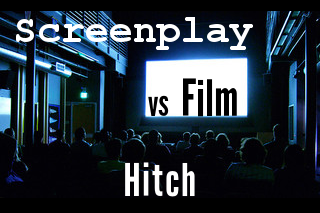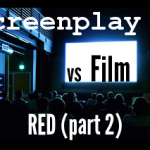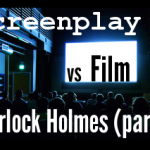Hitch, today’s screenplay vs film analysis is a request by SMW reader, Jarrid. Thanks for the suggestion!
There’s lots to learn from this 2005 blockbuster, especially if you want to write a commercially successful romantic comedy.
Starring Will Smith as Alex “Hitch” Hitchens, a date doctor who’s having trouble ensnaring the woman who’s caught his eye, Hitch made $179 million (domestic) at the box office.
However, there are a lot of differences between the film version and the 2001 draft penned by Kevin Bisch. While the script contained all the key ingredients of a solid romantic comedy, it didn’t contain the moments you probably still remember from the movie:
- Hitch’s disastrous date with Sara (Eva Mendes) on Ellis Island
- Hitch’s allergic reaction to seafood
- Hitch’s tutorial on how to dance…
- …and how to kiss
So what romantic comedy writing tips can you learn from the differences between Hitch the script and Hitch the film? Let’s take a look:
Romantic Comedy Screenwriting Tip #1: Meet in Motion
It’s always a good rule of thumb to imagine a scene playing out several different ways before deciding how to write it. This especially holds true when you’re introducing your hero.
Studying scenes from television provides us with a solid guideline for introducing your own romantic comedy heroes and heroines: do it in motion.
Have you noticed that characters on dramas and sit-coms do a lot of walking down hallways and corridors–even though their conversations could have easily taken place in an office? (Aaron Sorkin’s West Wing is famous for this.)
Even if characters remain in a room to do a long scene, they’ll move through the space, from its periphery to its center, for example.
In Amy Sherman-Palladino’s Gilmore Girls, two of the leading ladies will move from the kitchen island to the kitchen sink or to a heavy-duty coffee maker and back again. This action isn’t essential to the conversation, but it gives the scene an added bounce, a sense of energy and dynamism.
Let’s apply this principle to Hitch. In the 2001 screenplay draft I read, we met Eva Mendes’s character, Sara, at her desk:
INT. THE TRIBUNE, OFFICE – DAY
SARA GILES, a knock-out determined to downplay her looks, is on the phone, a dozen red roses on the desk in front of her.
SARA
…this is a bad time for me.
Sara’s workspace is the nerve center of the Trib’s “Fly on the Wall” desk, a widely read gossip/society page.
A few lines later:
GEOFF
Come on, flowers at work? All the other women jealous? That doesn’t work for you?
SARA
The last thing I need in this nest of vipers is jealousy. Plus…
(looking at the roses)
Red Roses? Not only lacking creativity, but coming on a little strong, don’t you think?
GEOFF
I’ve got a pregnant wife at home, Sara. It’s been a while since I’ve considered the tactical implications of roses.
Geoff drops a stack of photos on her desk.
GEOFF
Here’s the shots from the Goldin opening last night.
SARA
Anything good?
Sara flips through the shots rapid fire, stopping on the picture of Jordan [this is Albert in the movie] and Allegra arm-in-arm.
SARA
Hello! This is a great shot of Allegra Cole and…Nobody Special. Who’s this guy she’s with?
It’s not a bad introduction.
From it, you can conclude that Sara is more interested in finding the scoop rather than finding a romantic companion. But with a few minor tweaks, this scene was considerably enhanced.
In the movie, similar information was conveyed in a different way. Instead of meeting Sara at her desk, we meet her as she’s plowing through the newspaper office. Not only that, she’s just returned from her vacation…where she discovered dirty gossip on socialite Allegra Cole.
The movie scene conveys a lot of info in 2 minutes:
- From the way Sara moves, you can feel the energy of her ambition
- Because she managed to find a scoop during her vacay, you know she lives for the job
- You also know her need: to establish a life outside of work
- Finally, we’re also seamlessly introduced to the Allegra Cole subplot
It’s the first detail that I want to focus on. There are a couple ways to sit at a desk. There are several more ways to navigate a room.
If you structure your scenes with movement in mind, you give your actors more to work with. Your scenes will have more vitality.
That’s not to say that you can’t introduce your romantic comedy characters sitting down. One of the best character introductions ever penned is the one to Indiana Jones’s love interest, Marion, in Raiders of the Lost Ark.
She was seated at a small table.
In a remote Himalayan bar.
Participating in a drinking contest.
With a Nepalese giant.
Your “meet the hero” scene might not have that kind of appeal. If yours feels stagnant, see if adding some motion livens it up. For more inspiration, check out this crucial tip on writing hero introductions.
Romantic Comedy Screenwriting Tip #2: Keeping it commercial
Caution: this screenwriting tip may offend your artistic sensibilities. Read through until the end before you start to bristle.
A commercial movie isn’t supposed to push the envelope. It’s supposed to appeal to the masses. Which means that there are human behaviors which aren’t exactly tawdry or perverse, but which you wouldn’t want to include in a slick, commercial romantic comedy.
For example, in the screenplay draft of Hitch which I read, Allegra Cole’s character smoked. (In fact, one of Hitch’s smooth moves was to customize a Zippo lighter with photobooth pictures of Albert (Kevin James) and Allegra (Amber Valetta).
Romantic heroines don’t smoke. Not anymore. At least not in the United States of America. (The UK’s Bridget Jones still happily puffs away). Giving Allegra this vice was a tiny detail, but it struck a discordant note.
Another example: age difference. In most traditional romantic comedies, the hero and the heroine are of similar age. If they’re not, again, it can strike the wrong chord. (Check out screenwriting tip #1 from Crazy Stupid Love for another example.)
If you want to write a romance between a chain-smoking temp who just turned twenty and her sixty-year-old boss, you can. Your edgy tone and darkly humorous characterization can definitely get you noticed.
But will you sell this script for a lot of money? Unlikely…simply because unlike raunchy rom-coms, dark and edgy romantic comedies don’t usually make much moolah at the box office.
Figure out what you want to accomplish, and write accordingly. In television, you can write shows for the 8 PM hour. Or for the 10 PM hour. The 10 PM slot affords you greater flexibility because you can write more controversial scenes. But there’s no shame in either.
The same principle applies to writing feature-length films. There’s no shame in writing a commercial script intended for the broadest of markets. There’s no shame in writing a script that’s more arty–if that’s what YOU want to do.
But if you intend to write a purely commercial script, then commit yourself. Get rid of smoking heroines and unconventional age differences.
Romantic Comedy Screenwriting Tip #3: Make your Act One break timely
If you’ve been studying screenwriting for awhile, you’ve come across three-act structure. The first act break occurs approximately a quarter into your screenplay. It marks the completion of the setup and is where your hook kicks in.
What’s the hook of Hitch?
The hook is that a man who orchestrates dates between average men and beautiful women is having trouble securing the heart of the lady who’s caught his eye.
Armed with the hook and our knowledge of three-act structure, Act One would introduce us to Hitch, the girl who caught his eye, and show the two of them meeting.
(Because the date doctor concept is intriguing all on its own, it’d also be a sound strategy to introduce to the audience a possible client for Hitch to mentor.)
In the screenplay, we met Hitch and Sara and Jordan (who was renamed Albert Brennaman in the movie) during Act One. But because of an extensive flashback (more on that in screenwriting tip #4), Hitch and Sara didn’t meet till page 39. Since the script was 116 pages long, the first act break was delayed by about 10 pages.
In 99% of all romantic comedies, the hero and heroine meet each other BEFORE the first act break.
(Sleepless in Seattle being a notable exception.) If you delay their meeting, you better have a jolly good reason. The 2001 screenplay draft of Hitch didn’t.
Romantic Comedy Screenwriting Tip #4: Flashback killed the movie star
Flashbacks aren’t evil. Nobody complains about the lengthy flashback in Casablanca (although I question if Casablanca could get made by today’s studio system).
Quick cuts to the past also work really well on TV. New Girl makes use of them to great effect.
But as a beginner, you should be extremely cautious about using them in your romantic comedy. Flashbacks, by definition, take place in the past.
The past doesn’t have the same story energy as the present.
Invariably, flashbacks break up your story momentum, especially if they drag on for too long.
Even if your flashback is super-compelling, you invite another complication into your screenplay: your audience stops caring about what happens to your hero in the present because they’re much more interested in the intriguing events of the past.
If you’re repeatedly drawn to your flashback scene, you might want to ask yourself if your script should be about THAT story (and that time period) instead of the story you’re currently trying to tell.
In the original script draft of Hitch, Bisch included a flashback of approximately 10 pages during Act One. It wasn’t artistic fluff. The flashback showed us how Hitch viewed his college love interest, Cressida, as an almost supernatural being.
Later, when Cressida re-enters the picture, we’ll see that Hitch had built her up in his imagination, and she didn’t come even close to possessing all the amazing qualities he thought she had. The flashback also introduced us to another character, Liza. She’s the one who taught Hitch all about the art of love.
In the movie, the flashback was dramatically changed. Liza was gone. Cressida’s beautiful, but realistically so. It was a smart move.
Shortening the flashback helped maintain the movie’s momentum. It also helped forge a bond between Hitch and the audience as you’ll see in romantic comedy screenwriting tip #5.
Even better, by slimming down the flashback (and decreasing the importance of both Cressida and Liza), the movie had more time to showcase the comedic hijinks of Hitch tutoring Albert in the ways of love (which is the source of many of the films best gags).
If your heart’s set on your flashback, assess the risks versus the rewards. Oftentimes, your screenplay will be much stronger without the flashback.
Alternately, you can try beginning your movie with the flashback–which would then make it your movie’s starting point instead of a flashback. This approach typically eliminates the drawbacks I described above.
For an excellent example of this, check out the beginning of JJ Abrams’s Star Trek reboot »
Romantic Comedy Screenwriting Tip #5: Make the rom-com stars vulnerable
In the film version of Hitch, Hitch’s 10-page flashback to his college life was whittled down to 2 minutes. It was changed more dramatically in other ways too. In the screenplay, Hitch never dates Cressida. In the movie flashback, he did, because the important point was how he lost her.
Hitch confesses his love to Cressida with such intensity, he scares her away. She wasn’t ready for such depth of emotion. This moment was extremely powerful, because in real life, people usually go to great lengths to avoid making themselves as vulnerable as Hitch did.
It’s that moment of vulnerability which makes the audience care about what happens to Hitch. Because he did put himself out there, and got rejected, we really want to see him get the girl (Sara).
The movie version of Hitch expanded Sara’s vulnerability too. In the original screenplay draft, Sara was averse to dating because she had grown up with two brothers.
In her words:
INT. TRIBUNE NEWSROOM – DAY
Sara is going over some papers while talking on the phone, Geoff sits on the corner of her desk.
SARA
(into phone)
What, this Friday? That’s a really great offer but I have to spend the weekend at the bedside of my sister who has a degenerative tissue disease.
Geoff’s face drops. Sara shakes her head to indicates she’s fibbing.
SARA
Well, we’re not sure if it’s the killer mold…but I’ll be at Saint Vincent’s, if you want to pop in. Just ask for the “Hot Zone” wing, ‘kay? Bye now.
She hangs up and rolls her eyes.
SARA
That guy just invited me to get lobster. In Monaco.
GEOFF
(appalled)
Sara!
SARA
Don’t give me that, “you’re too picky.” This guy makes Warren Beatty look like an altar boy. I don’t have time for it.
GEOFF
Not that. What’s about your sister?
SARA
Oh, I don’t even have a sister. I have two brothers, so I know that anything remotely real or complicated early on will make men run for the hills.
This explanation for why she avoids relationships makes sense.
You understand where she’s coming from, sure…but do you feel for her? Contrast this explanation with her revelation to Hitch which occurs 66 minutes into the movie.
They’re at her apartment. Hitch is woozy from Benadryl. Taking advantage of the moment, Sara confesses that her sister almost died when Sara was 10 years old.
The experience deeply affected her, causing her to freeze out other people, so she doesn’t expose herself to the risk of losing them.
In this scene, both Hitch and Sara are stripped of their armor, cementing the idea that they’re perfect for each other. (Bonus: Sara’s anecdote about her sister also sets up a critical moment in the climax.)
Making your characters vulnerable is the key to crafting a romantic comedy which people want to watch over and over and over again. Repeat visits = box office gold.
For more inspiration, check out:
- screenwriting tip #7 from Crazy Stupid Love
- screenwriting tip #7 from Notting Hill
- screenwriting tip #9 from Casino Royale
The last one is probably not an example you were expecting, but trust me!
Romantic Comedy Screenwriting Tip #6: Do a character check
Make a list of all the characters in your romantic comedy. Do you need all of them? (Especially all the friends and work colleagues of the hero/heroine?)
Is there a way to combine characters into one person…a person who’s more than a one-layer exposition device?
In romantic comedy screenwriting tip #4, you saw how Albert’s role was expanded in the movie. Now, let’s take a look at how Liza’s role was cut.
In Hitch’s lengthy flashback, we learned she was his mentor, the one who taught him all the ways of love. At first glance, this might seem like necessary information…but is it?
Can’t the audience just infer that somehow, after getting burned by Cressida, Hitch spent significant time working on his pickup skills and became so good at it, it’s become a lucrative business for him?
Remember, by taking the time to show Hitch’s transformation, you won’t be able to explore other story avenues–namely Hitch’s transformation of Albert from a schlub into a dating machine.
Transforming Albert lends itself to comic set pieces. That’s one reason to jettison the Liza subplot and expand Albert’s.
There’s another reason too: Sara’s desperation to figure out how Albert landed Allegra leads to break-ups all around, the “all is lost” moment which ends Act Two.
Additionally, even though Albert tries to follow Hitch’s choreographed moves, Albert’s genuine affection for Allegra shines through. This creates not only great comedy gags but also a thematic counterpoint to Hitch’s glossy, Photoshopped idea of love.
Granted, in the script, we weren’t done with Liza after the flashback. She popped up again in Act Three, still the sage mentor, who advises Hitch to win Sara back by being himself. But if you take a closer look, this scene isn’t necessary either.
Hitch doesn’t need Liza to experience his own realization. All he needs to do is observe Albert’s reaction to losing Allegra and compare his reaction to losing Sara (which he does in the movie).
This is why it’s always a good idea to think of multiple ways your concept can play out. You can analyze each iteration, evaluate them in turn, and then choose the one which produces the strongest, most satisfying story.
Watching a blank screen (with modifications) by Kenneth Lu





















Comments on this entry are closed.
Question: is 28 (female) – 45 (male) age gap of my two leads commercially catastrophic?
Hi Jon,
Unless it’s absolutely essential to give your characters specific ages, I think the general rule of thumb is to describe their ages loosely, so you can cast a wider net for actors and actresses.
Also, for a cute, commercial romantic comedy, a 17-year age gap does seem a bit much.
Perhaps describing your heroine being in her early 30s and your hero being in his late 30s would be a stronger choice.